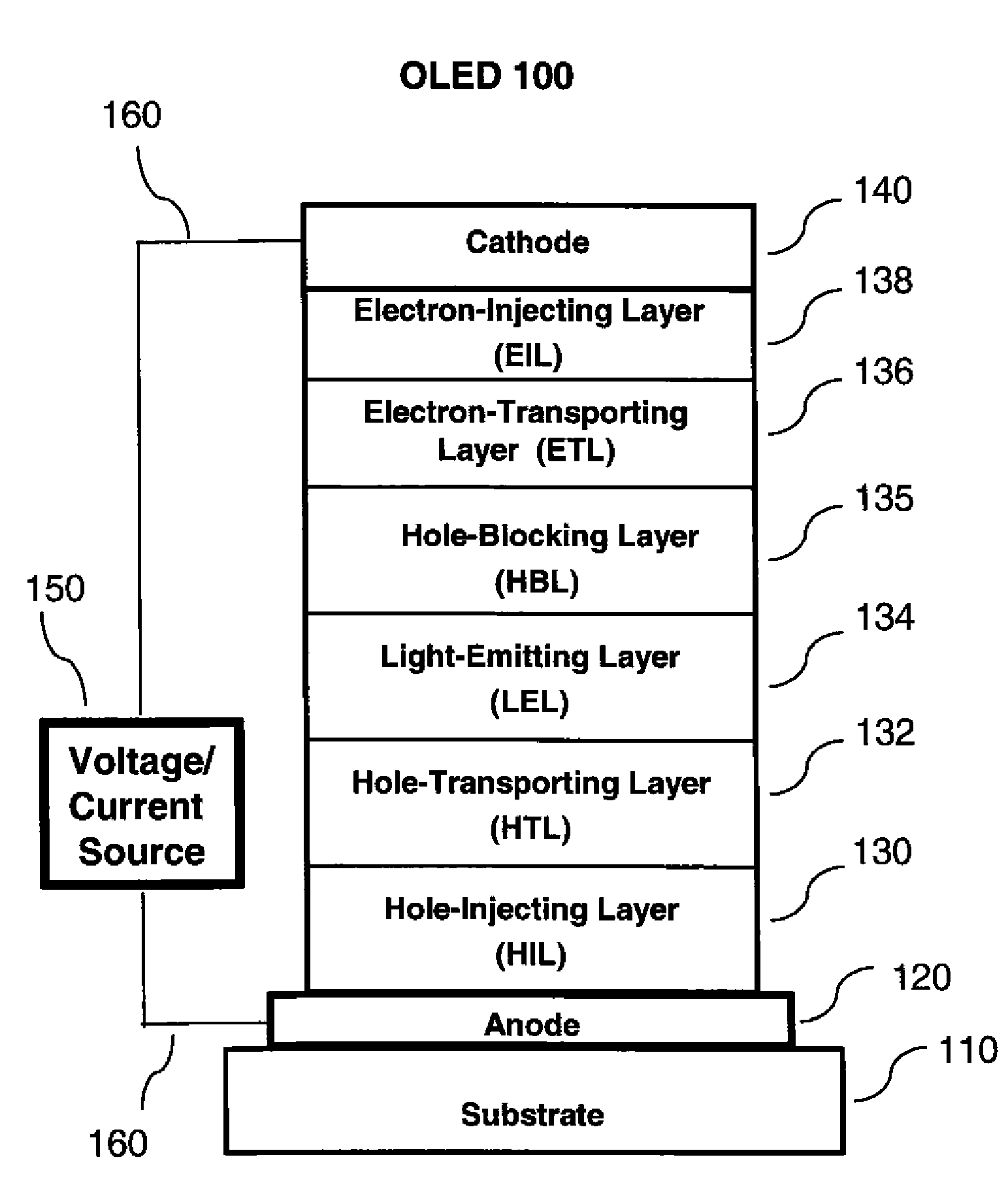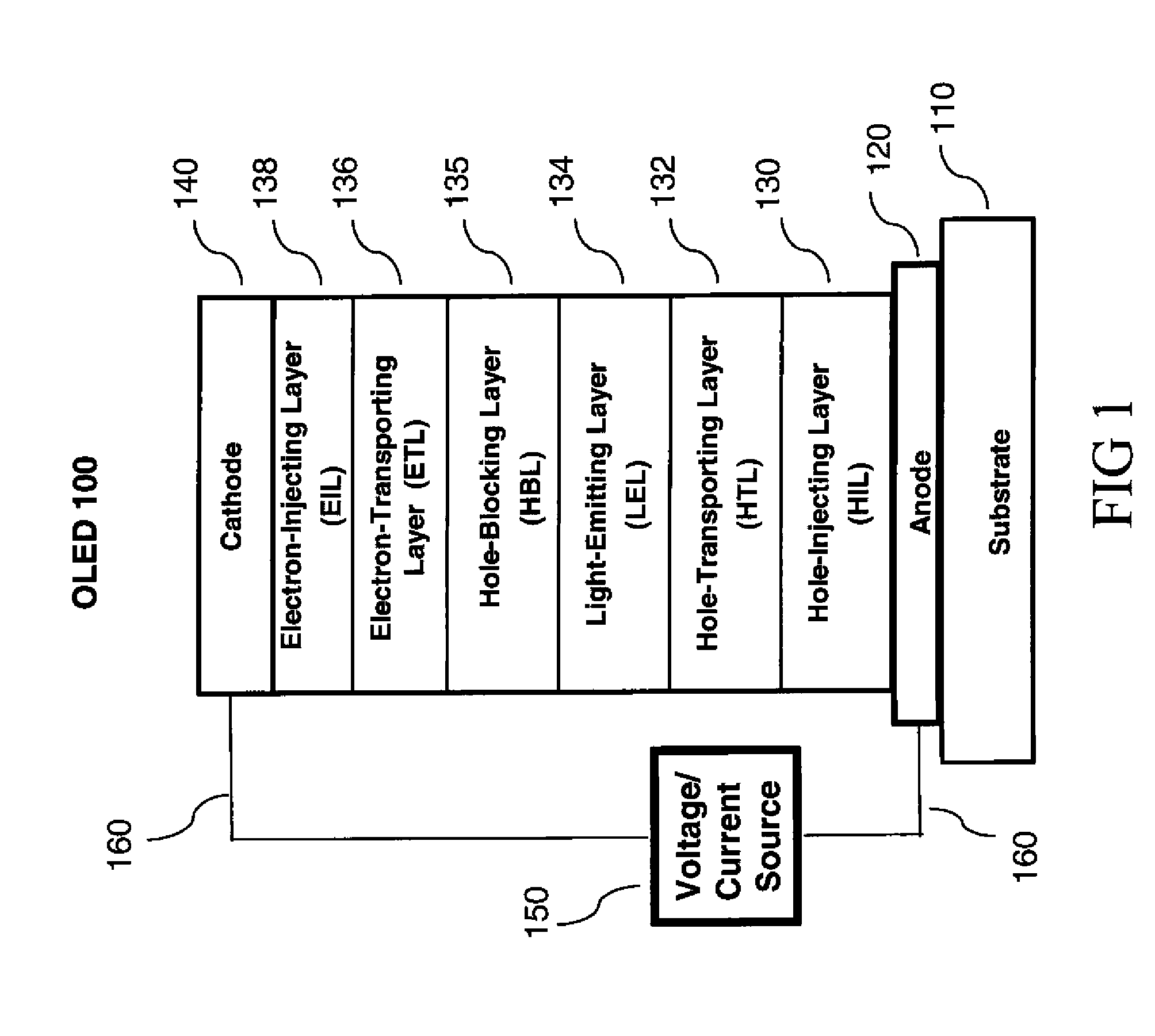OLED device with substituted acridone compounds
a technology of acridone and acridone, which is applied in the direction of organic semiconductor devices, discharge tubes luminescnet screens, other domestic articles, etc., can solve the problems of low drive voltage, device performance limitations, and many undesirable applications, so as to improve process and display efficiency and improve the effect of efficiency
- Summary
- Abstract
- Description
- Claims
- Application Information
AI Technical Summary
Benefits of technology
Problems solved by technology
Method used
Image
Examples
experimental examples
Examples 1 and 2
Preparation of Inventive Compounds A-2 and A-1
[0312]To an 100 mL dry, three-necked round flask were charged 4-5 bromo-4′-(9-carbazolyl)biphenyl (2.0 g, 5 mmol) (Ref. Chem. Mater. 1998, 10, 2235), 9(10H)-acridone (1.0 g, 5 mmol), K2CO3 (1.0 g, 7.5 mmol), copper (0.33 g, 5 mmol), CuI (0.1 g), 2,2,6,6-tetramethyl-3,5-heptanedione (0.2 g), and MS-dried DMF (30 mL). The mixture was degassed and refluxed under nitrogen atmosphere for 24 h (The reaction may have completed in less than 24 h). After cooling to room temperature, the precipitates from the reaction mixture were collected by filtration, washed with 3 N HCl, water and methanol, and dried in air. The light yellow solid was dissolved in CH2Cl2 (small amount of copper was left as brown particles) and purified by column chromatography on silica gel with CH2Cl2-EtOAc (40:1 v / v) as eluting solvents. The major fraction was collected and evaporation of the solvents afforded 2.1 g of pure product A-2, yield 82%. The materi...
example 3
Preparation of Devices 3.1 through 3.4.
[0313]A series of EL devices (3.1 through 3.4) were constructed in the following manner:[0314]1. A glass substrate coated with an 85 nm layer of indium-tin oxide (ITO), as the anode, was sequentially ultrasonicated in a commercial detergent, rinsed in deionized water, and exposed to oxygen plasma for about 1 min.[0315]2. Over the ITO was deposited a 1 nm fluorocarbon (CFx) hole-injecting layer (HIL) by plasma-assisted deposition of CHF3 as described in U.S. Pat. No. 6,208,075.[0316]3. Next a layer of hole-transporting material 4,4′-Bis[N-(1-naphthyl)-N-phenylamino]biphenyl (NPB) was deposited to a thickness of 75 nm (HTL).[0317]4. Next an exciton block layer (EBL) of 10 nm of 4-(9H-carbazol-9-yl)-N,N-bis[4-(9H-carbazol-9-yl)phenyl]-benzenamine was deposited.[0318]5. A 20 nm light-emitting layer (LEL) composed of host material as listed in Table 1 and 6% phosphorescent dopant Ir(ppy)3 was then deposited.[0319]6. A 50 nm electron-transporting lay...
example 4
Preparation of Devices 4.1 through 4.3.
[0324]A series of EL devices (4.1 through 4.3) were constructed in the same manner as Devices 3.1-3.4 except that the light-emitting phosphorescent material in step 5 was replaced by 1% FD-54, a light-emitting fluorescent material, and the thickness of the ETL in step 6 was decreased to 40 nm.
[0325]The devices thus formed were tested for luminous efficiency at an operating current of 1 mA / cm2 and the results are reported in Table 2.
TABLE 2Experimental ResultsDriveExampleVolt.Efficiency(Type)LEL% EQE(Volts)(cd / A)4.1Comp-12.13.872.58(Comparative)4.2A-14.12.915.67(Inventive4.3A-25.33.435.55(Inventive)
[0326]Table 1 shows experimental results for a LEL using a fluorescent light-emitting compound. The inventive compounds A-1 and A-2, both of which bear one acridone and one diphenylamine or carbazole group, clearly offer improved performance in terms of efficiency and drive voltage relative to Comp-1, which lacks the diarylamino or carbazole group of ...
PUM
 Login to View More
Login to View More Abstract
Description
Claims
Application Information
 Login to View More
Login to View More - R&D
- Intellectual Property
- Life Sciences
- Materials
- Tech Scout
- Unparalleled Data Quality
- Higher Quality Content
- 60% Fewer Hallucinations
Browse by: Latest US Patents, China's latest patents, Technical Efficacy Thesaurus, Application Domain, Technology Topic, Popular Technical Reports.
© 2025 PatSnap. All rights reserved.Legal|Privacy policy|Modern Slavery Act Transparency Statement|Sitemap|About US| Contact US: help@patsnap.com



